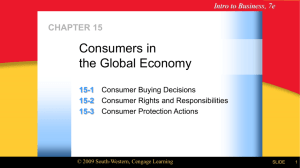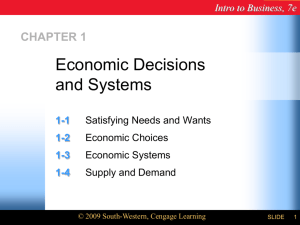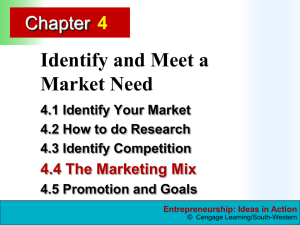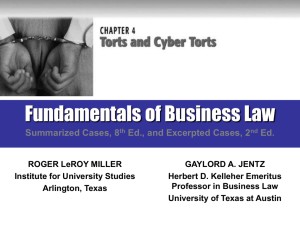Economic Decisions and Systems
advertisement
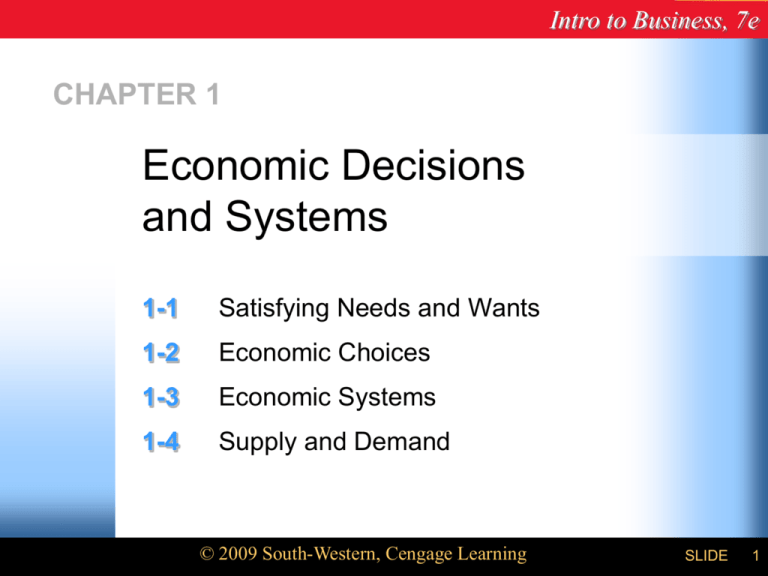
Intro to Business, 7e CHAPTER 1 Economic Decisions and Systems 1-1 Satisfying Needs and Wants 1-2 Economic Choices 1-3 Economic Systems 1-4 Supply and Demand © 2009 South-Western, Cengage Learning SLIDE 1 Intro to Business, 7e 1-1 Satisfying Needs and Wants OBJECTIVES 1. Explain the difference between needs and wants. 2. Distinguish between goods and services. 3. Describe the types of economic resources. © 2009 South-Western, Cengage Learning SLIDE 2 Intro to Business, 7e Chapter 1 Key Terms needs wants goods services economic resources © 2009 South-Western, Cengage Learning SLIDE 3 Intro to Business, 7e Chapter 1 NEEDS AND WANTS Needs are essential Wants add to the quality of life Needs and wants are unlimited At least in PA, needs are (for the most part) not taxed. Wants tend to be taxed. © 2009 South-Western, Cengage Learning SLIDE 4 Intro to Business, 7e With your partner, make a list of Chapter 1 G&S that are wants but are “sold” to us as needs… Ex: TV . . . . . © 2009 South-Western, Cengage Learning SLIDE 5 Intro to Business, 7e Chapter 1 Needs and Wants have changed over the years In small groups, prepare a list of five needs that you agree would be similar to the needs of your parents when they were your age. Then list five needs of yours that you agree would likely be different from your parents when they were your age. Be prepared to justify why the items on your list are needs and not wants. Lists will be used at the end of the period. © 2009 South-Western, Cengage Learning SLIDE 6 Intro to Business, 7e Chapter 1 Checkpoint >> What is the difference between a need and a want? Answer Needs are those things required to live, such as food, clothing, and shelter. Wants are things that add comfort and pleasure to our lives such as television, music CDs, and movies. The service industry (largest industry) addresses more wants than needs. How does this relate to unemployment rates during an economic recession? © 2009 South-Western, Cengage Learning SLIDE 7 Intro to Business, 7e Chapter 1 Additional Needs Clean air Water Good education Employment Safety Transportation Medical Care Medication © 2009 South-Western, Cengage Learning SLIDE 8 Intro to Business, 7e Chapter 1 GOODS AND SERVICES Goods and services for businesses and consumers Both businesses and individuals are consumers but have different goals Different quantities to purchase For use in business AND for resale © 2009 South-Western, Cengage Learning SLIDE 9 Intro to Business, 7e Chapter 1 GOODS AND SERVICES (continued) The U.S. economy U.S. is the largest producer of G&S in the world, Americans are also the largest consumer group in the world. Drawbacks: Produce more garbage per person per year. More debt through credit cards and loans. © 2009 South-Western, Cengage Learning SLIDE 10 Intro to Business, 7e Chapter 1 ECONOMIC RESOURCES~ the means through which G&S are produced Natural Resources materials supplied by nature Human Resources people who produce G&S Capital Resources products and money used in the production of G&S © 2009 South-Western, Cengage Learning SLIDE 11 Intro to Business, 7e Chapter 1 ECONOMIC RESOURCES (continued) Resources are limited ~ SCARCITY Individuals, businesses, and countries compete for access and ownership. The more scarce, the higher the price and the less that can be produced. © 2009 South-Western, Cengage Learning SLIDE 12 Intro to Business, 7e Chapter 1 Examples of each type of resource: Natural: water, land, trees, animals, and minerals. Human: labor (people who run farms and factories, transport goods, provide services, or manage businesses, even Entrepreneurs…) Capital: money, land, buildings, tools, and equipment. Venture Capital © 2009 South-Western, Cengage Learning SLIDE 13 Intro to Business, 7e Chapter 1 Reinforcement 1-1 Page 11 1-4 © 2009 South-Western, Cengage Learning SLIDE 14 Intro to Business, 7e 1-2 Economic Choices Goals 4. Understand the basic economic problem. 5. Explain the steps in the decision-making process. © 2009 South-Western, Cengage Learning SLIDE 15 Intro to Business, 7e Chapter 1 Key Terms scarcity economic decision-making tradeoff opportunity cost © 2009 South-Western, Cengage Learning SLIDE 16 Intro to Business, 7e Chapter 1 THE BASIC ECONOMIC PROBLEM… SOLVED? SCARCITY! = basic economic problem We make CHOICES as people and as a nation regarding our scarce economic resources Economic Decision Making Process Brainstorm effective AND ineffective decision makers. What do you think makes them effective/ineffective? What do you think they do or do not do? Tradeoffs and opportunity costs… © 2009 South-Western, Cengage Learning SLIDE 17 Intro to Business, 7e Chapter 1 What is a tradeoff? When you have to give something up to have something else. Example: I want to go to the dance next weekend, but the tradeoff will be that I will not be able work my usual shift at my parttime job. © 2009 South-Western, Cengage Learning SLIDE 18 Intro to Business, 7e Chapter 1 What is opportunity cost? Opportunity cost is the value of the next best alternative that you don’t choose. It is what you are willing to give up in order to have your first choice. • In the ‘dance’ example, the opp. cost is the money that I will not earn if I take off work to go to the dance. © 2009 South-Western, Cengage Learning SLIDE 19 Intro to Business, 7e Chapter 1 THE DECISION-MAKING PROCESS Poor Business Decisions in our History How to avoid a bad decision… http://blog.vistage.com/business-leadership/how-to-avoid-a-bad-decision-small-business-owners-can-help-themselves/ 1. Define the problem. 2. Identify the choices. 3. Evaluate the advantages and disadvantages of each choice. 4. Choose one. 5. Act on your choice. 6. Review your decision. © 2009 South-Western, Cengage Learning SLIDE 20 Intro to Business, 7e Chapter 1 1. Define the problem Be specific! Class Example: © 2009 South-Western, Cengage Learning SLIDE 21 Intro to Business, 7e Chapter 1 2. Identify the choices There are often MANY alternatives. Consider each possibility! Create an actual list of realistic possibilities. Class Example: © 2009 South-Western, Cengage Learning SLIDE 22 Intro to Business, 7e Chapter 1 3. Evaluate the advantages and disadvantages of each choice. Weigh the PROs and CONs of each possibility. Write them down! (This process works…For real!) Class Example: © 2009 South-Western, Cengage Learning SLIDE 23 Intro to Business, 7e Chapter 1 4. Choose one. Realize that every choice has its consequences and prepare yourself to handle them. Know and understand the tradeoffs and opportunity costs associated with your decision. Class Example: © 2009 South-Western, Cengage Learning SLIDE 24 Intro to Business, 7e Chapter 1 5. Act on your choice. Timing is critical! When should you act to maximize your results? Class Example: © 2009 South-Western, Cengage Learning SLIDE 25 Intro to Business, 7e Chapter 1 6. Review your decision. Would you make the same choice again? What (if anything) would you do differently? This step should make future decisions easier. Class Example: © 2009 South-Western, Cengage Learning SLIDE 26 Intro to Business, 7e Chapter 1 With your partner, complete the following… (on the paper used for your Bell Ringer activity) You have just been given $10,000, with the only stipulation that it MUST be spent on a service or something tangible (cannot be saved). Using just the first 4 steps of the 6-step decision making process, decide what you will do with the money. List each step separately and be thorough! In steps 2 and 3, consider a minimum of two possible alternatives with pros and cons for each. © 2009 South-Western, Cengage Learning SLIDE 27 Intro to Business, 7e Chapter 1 Reinforcement Page 15 1-3 and Choose 4 or 5 © 2009 South-Western, Cengage Learning SLIDE 28 Intro to Business, 7e 1-3 Economic Systems Goals 6. Identify the three economic questions. 7. Differentiate among the main types of economic systems. 8. Describe the economic system of the United States. © 2009 South-Western, Cengage Learning SLIDE 29 Intro to Business, 7e Chapter 1 Key Terms economic system command economy market economy traditional economy mixed economy capitalism © 2009 South-Western, Cengage Learning SLIDE 30 Intro to Business, 7e Chapter 1 THE THREE ECONOMIC QUESTIONS What to produce? Butter V. Guns Dilemma How to produce? Skilled labor, technology, automation, simple tools, hand-made, etc… For whom to produce? Whose needs and wants to satisfy © 2009 South-Western, Cengage Learning SLIDE 31 Intro to Business, 7e Chapter 1 Economic System: A nation’s plan for answering the 3 economic questions and for dealing with the basic economic problem of scarcity. 3 main types of economic systems… Traditional Command Market (ofMixed) © 2009 South-Western, Cengage Learning SLIDE 32 Intro to Business, 7e Chapter 1 TRADITIONAL ECONOMY Operate according to tradition and custom Developing area of Latin America, Asia, Africa, and the Middle East Traditions still passed down from generation to generation Consume their own products Meets basic needs for shelter, food, and clothing © 2009 South-Western, Cengage Learning SLIDE 33 Intro to Business, 7e Chapter 1 COMMAND ECONOMY ‘Centrally Planned’ economy Resources are owned and controlled by the government Government answers the 3 economic questions Limited individual freedom Cuba, Libya, Iran, N. Korea, Myanmar (Burma), Saudi Arabia, China, and Vietnam © 2009 South-Western, Cengage Learning SLIDE 34 Intro to Business, 7e Chapter 1 MARKET ECONOMY Resources are owned and controlled by the people of the country 3 Economic questions are answered by individuals through buying and selling of G&S Consumers and businesses make decisions based on their own selfinterest © 2009 South-Western, Cengage Learning SLIDE 35 Intro to Business, 7e Chapter 1 (MIXED ECONOMY) Combines Market and Command economy Why is government involvement necessary in a Market economy? © 2009 South-Western, Cengage Learning SLIDE 36 Intro to Business, 7e Chapter 1 Market Vs Command Economy Socialism Capitalism Donald Trump, Bill Gates, etc… Other Wealthy People High Low Income Income Middle Mid-Low Income Income Equal Piece of the Pie Equal Piece of the Pie Equal Piece of the Pie Gov’t Control Equal Piece of the Pie © 2009 South-Western, Cengage Learning Equal Piece of the Pie Equal Piece of the Pie Equal Piece of the Pie SLIDE 37 Intro to Business, 7e Chapter 1 Checkpoint >> What are the main differences among the three economic systems? Answer The main differences between the economic systems are found in the ways in which the three economic questions are answered. © 2009 South-Western, Cengage Learning SLIDE 38 Intro to Business, 7e Chapter 1 4 Characteristics/Principles of the U.S. ECONOMIC SYSTEM Private property Freedom of choice Profit ~ (Profit Motive) Competition Discuss with your partner an example of each characteristic/principle in our economy. © 2009 South-Western, Cengage Learning SLIDE 39 Intro to Business, 7e Chapter 1 Reinforcement Page 22 1-3 and Choose 4 or 5 © 2009 South-Western, Cengage Learning SLIDE 40 Intro to Business, 7e 1-4 Supply and Demand Goals 9. Describe supply and demand orally and with graphs. 10. Discuss how supply and demand affect prices of products and services. M&M Activity © 2009 South-Western, Cengage Learning SLIDE 41 Intro to Business, 7e Chapter 1 Key Terms consumer producers demand supply market price © 2009 South-Western, Cengage Learning SLIDE 42 Intro to Business, 7e Chapter 1 PARTICIPATING IN A MARKET ECONOMY Consumers set demand Producers establish supply A graphic view © 2009 South-Western, Cengage Learning SLIDE 43 Intro to Business, 7e Chapter 1 Car Wash Example 10 9 8 7 6 5 4 3 2 1 0 MARKET PRICE $0 $2 $4 $6 $8 $10 © 2009 South-Western, Cengage Learning $12 SLIDE 44 Intro to Business, 7e Chapter 1 DEMAND AND SUPPLY © 2009 South-Western, Cengage Learning SLIDE 45 Intro to Business, 7e Chapter 1 MARKET PRICE © 2009 South-Western, Cengage Learning SLIDE 46 Intro to Business, 7e Chapter 1 Checkpoint >> How does the price of a product affect demand and supply? Answer As prices decrease, the number of consumers willing and able to purchase the product (demand) will increase. As prices increase, businesses will be willing to supply larger quantities of the product. © 2009 South-Western, Cengage Learning SLIDE 47 Intro to Business, 7e Chapter 1 DETERMINING PRICE Factors influencing demand Weather, climate, timing Competition, substitutes Factors influencing supply Weather, climate, natural disasters Competitors Determining market price Supply, Demand, and Competition © 2009 South-Western, Cengage Learning SLIDE 48 Intro to Business, 7e Chapter 1 Reinforcement 1-4 Page 26 (1-3 and 4 or 5) & CHAPTER 1 REVIEW Pages 28-29 (1-30) © 2009 South-Western, Cengage Learning SLIDE 49
